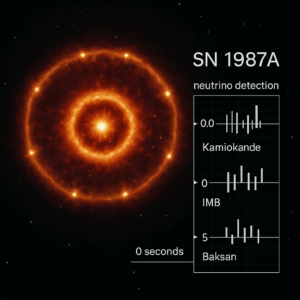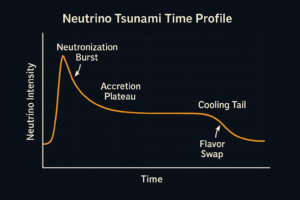When a massive star collapses in a cosmic cataclysm, what kills it is not just gravity—but a flood of ghost particles. Type II supernovae, some of the most violent explosions in the universe, release almost all their energy not as light, but as neutrinos. And not just any burst—some models suggest a structured, layered tsunami of neutrino emission that ripples outward before light even escapes. These neutrino tsunamis might hold the key to understanding stellar death, element formation, and even the early structure of the universe.
What Is a Type II Supernova?
 Type II supernovae occur when a massive star (more than 8 solar masses) runs out of nuclear fuel. The fusion reactions that once supported its core cease, and gravity suddenly wins. The core collapses in milliseconds, forming a neutron star—or, in some cases, a black hole.
Type II supernovae occur when a massive star (more than 8 solar masses) runs out of nuclear fuel. The fusion reactions that once supported its core cease, and gravity suddenly wins. The core collapses in milliseconds, forming a neutron star—or, in some cases, a black hole.
The outer layers of the star fall inward, then rebound violently off the stiffening neutron-rich core. This rebounding “shock wave” produces the luminous explosion we observe. But here’s the twist: less than 1% of the energy is emitted as light. Over 99% of the energy is carried away by neutrinos—nearly massless, chargeless particles that interact only via the weak force.
Neutrinos: Nature’s Escape Artists
Neutrinos are notoriously elusive. Billions pass through your body every second, undetected. In supernovae, they are not a by-product—they are the main event.
As the collapsing core reaches densities beyond that of atomic nuclei, protons and electrons combine into neutrons, releasing electron neutrinos via inverse beta decay. This initial phase produces an intense, sharp burst of neutrinos, called the neutronization burst.
Following this, a sustained emission of neutrinos of all flavors—electron, muon, and tau—radiate outward as the proto-neutron star cools. This emission lasts 10–15 seconds, longer than the visual supernova itself.
The Neutrino Tsunami Hypothesis
Not all neutrino emissions are equal. Some simulations suggest that the flow of neutrinos from a core-collapse supernova resembles a tsunami: a structured, layered burst with distinct phases, amplitudes, and flavor transitions.
Here’s how this ghostly tsunami unfolds:
- Neutronization Peak – A sharp burst lasting ~10 milliseconds as the core bounces.
- Accretion Phase – A high-energy plateau of neutrino flux lasting ~0.5–1 second as stellar matter rains onto the proto-neutron star.
- Cooling Phase – A slow decay of neutrino output over 10–15 seconds as the neutron star thermally stabilizes.
Each phase differs not just in intensity, but in neutrino flavor and energy spectrum. The “wave” structure arises from quantum oscillations and self-interactions between neutrinos themselves—leading to spectral swaps, bipolar modes, and collective flavor transformations.
Why Call It a Tsunami?
The term “neutrino tsunami” is metaphorical, but apt:
- Like a tsunami, the emission is sudden, massive, and layered.
- It precedes the visual shock wave—neutrinos escape the star’s core seconds before photons do.
- It transports almost all the energy of the explosion across the cosmos, potentially triggering distant detectors before telescopes see anything.
The tsunami analogy also underscores the challenge: like a wave, this phenomenon is shaped by many variables—mass, metallicity, rotation, magnetic fields—making each neutrino burst potentially unique.
How We Know: SN 1987A and Neutrino Detectors
 In 1987, a supernova occurred in the Large Magellanic Cloud. It was the first (and only) time that supernova neutrinos were detected on Earth.
In 1987, a supernova occurred in the Large Magellanic Cloud. It was the first (and only) time that supernova neutrinos were detected on Earth.
Three detectors—Kamiokande II, IMB, and Baksan—recorded 24 neutrinos over 13 seconds. That may sound trivial, but it confirmed theoretical predictions: energy release, timing, and spectrum.
More importantly, the neutrinos arrived hours before the visible light, offering a foretaste of future neutrino astronomy.
Since then, next-gen detectors like Super-Kamiokande, DUNE, and IceCube have been designed to capture much larger volumes of data—especially for the elusive flavor-specific waves within the neutrino tsunami.
Oscillations and Collective Effects
 One of the strangest aspects of the neutrino tsunami is flavor oscillation. Neutrinos exist in three flavors—electron, muon, and tau—but can morph between them in flight.
One of the strangest aspects of the neutrino tsunami is flavor oscillation. Neutrinos exist in three flavors—electron, muon, and tau—but can morph between them in flight.
In the dense environment of a supernova core, neutrino-neutrino interactions become significant. Unlike in vacuum or solar environments, these particles affect each other’s oscillation behavior in nonlinear ways.
This leads to:
- Spectral swaps: energy ranges where one flavor completely converts into another.
- Bipolar oscillations: synchronized flip-flopping between flavors, analogous to a pendulum.
- Shock wave imprints: features in the flavor spectrum caused by the passage of matter shock fronts.
These effects mean that detecting a neutrino tsunami would not only confirm the explosion, but also provide insights into neutrino mass hierarchy, CP violation, and even conditions inside the collapsing star.
Astrophysical and Cosmological Implications
The study of neutrino tsunamis is not just academic. It could answer some of the most profound questions in physics:
- Element Formation: Heavy elements like gold and uranium are thought to form via rapid neutron capture (r-process), possibly catalyzed by neutrino fluxes.
- Dark Matter Constraints: The behavior of neutrinos offers clues about thermal relics and sterile neutrinos.
- Neutrino Mass Ordering: Observing which flavors arrive when may reveal whether neutrinos follow a normal or inverted mass hierarchy.
- Early Warning System: Neutrino bursts from a nearby star could serve as a cosmic alarm system—giving astronomers time to aim instruments at the impending explosion.
What If Betelgeuse Explodes?
Betelgeuse, a red supergiant 600 light-years away, is a prime candidate for a Type II supernova in the (astronomically) near future. If it were to explode:
- Neutrino detectors would receive a tsunami of particles hours before the light.
- Tens of thousands of neutrinos would be detected, providing unprecedented data.
- The tsunami profile could be reconstructed with detail: phase-by-phase, flavor-by-flavor.
It would be the defining event for neutrino physics, gravitational wave science, and supernova modeling.
TL;DR
- Type II supernovae release over 99% of their energy as neutrinos, not light.
- The neutrino tsunami refers to a multi-phase, structured burst of neutrino emission during stellar collapse.
- These emissions encode data about core physics, neutrino oscillations, and supernova dynamics.
- Future detectors may capture these waves in detail, offering early warnings and insights into fundamental physics.
- Events like a Betelgeuse supernova could trigger a revolution in neutrino astronomy.
References
- Janka, H.-T. et al. (2007). “Theory of Core-Collapse Supernovae.” Physics Reports, 442(1), 38–74.
- Mirizzi, A., Tamborra, I., et al. (2016). “Supernova Neutrinos: Production, Oscillations, and Detection.” Rivista del Nuovo Cimento, 39(1), 1–112.
- Duan, H., Fuller, G. M., & Qian, Y.-Z. (2010). “Collective Neutrino Oscillations.” Annual Review of Nuclear and Particle Science, 60, 569–594.
- Hirata, K. et al. (1987). “Observation of a Neutrino Burst from the Supernova SN1987A.” Physical Review Letters, 58(14), 1490–1493.
- Scholberg, K. (2012). “Supernova Neutrino Detection.” Annual Review of Nuclear and Particle Science, 62, 81–103.
Discussion
If the next nearby supernova sends us a tsunami of neutrinos—will we be ready to read its message before the universe lights up?
